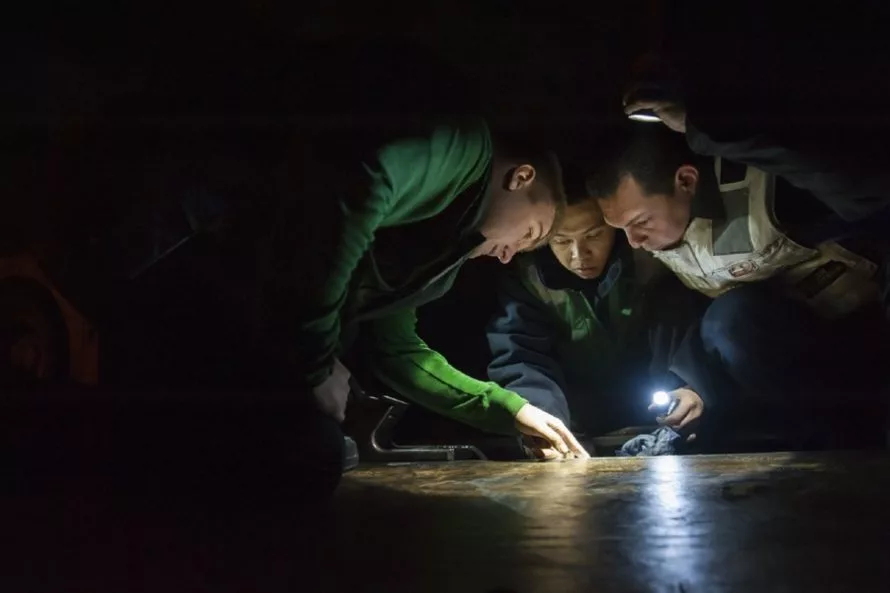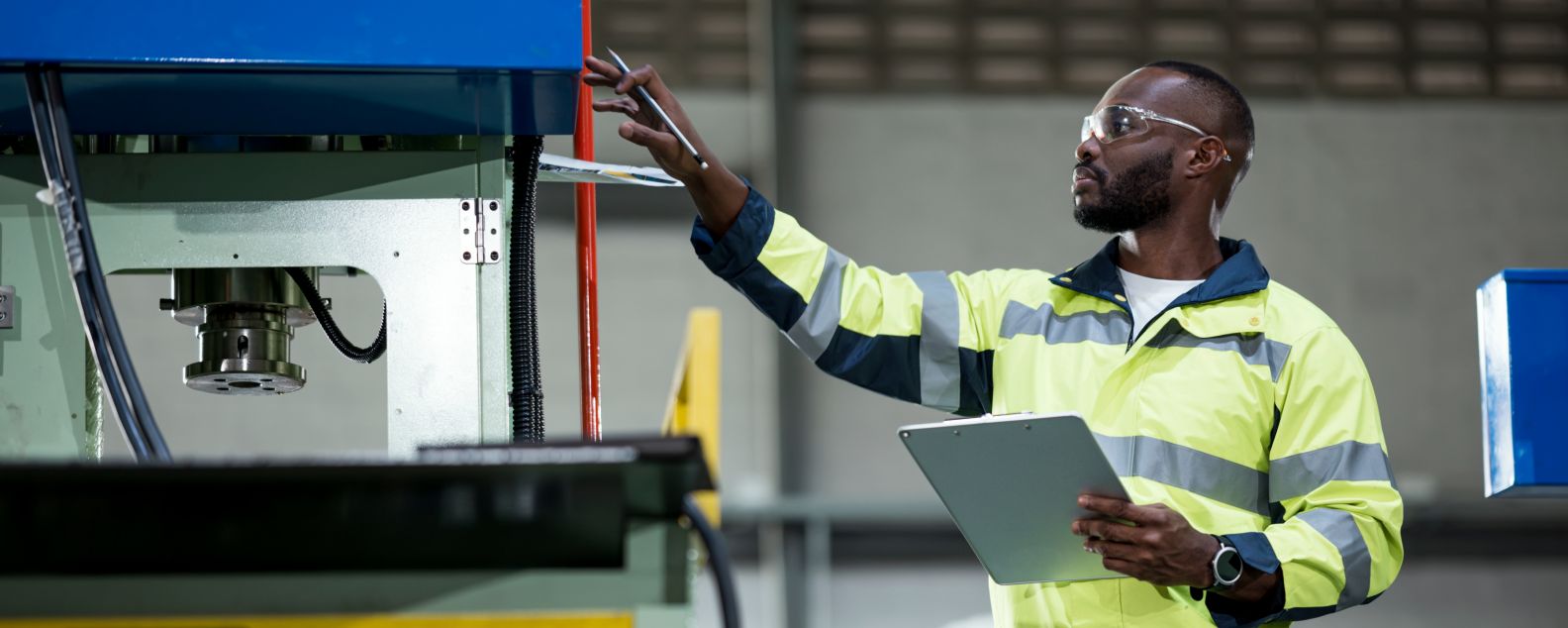Table of Content
- What is Visual Inspection?
- Types of Visual Inspection
- How can Drones help with Visual Inspections?
- Benefits of Visual Inspection?
- Key Takeaways
- FAQs
Hey Avenger—oops, I mean, engineer… Sometimes, I feel like you’re an Avenger from the Marvel movies, always in control of dangerous situations. Just as nothing escapes Iron Man’s sharp eyes, you keep a close watch on the equipment under inspection. Like an Avenger, you have your own cutting-edge technology to help you excel at work.
Here, we’re sharing tools, technologies, and skills to help our brave heroes on the job. Keep reading, Marvel hero…
What is Visual Inspection?

Visual inspection is a method in Non-destructive Testing, that relies on the human eye to assess the surface conditions of materials, structures, and components. This method involves a structured methodology to ensure comprehensive scrutiny. Operators conducting visual inspections follow a systematic approach, beginning with thorough planning and preparation.
1. Methodology
Visual inspection relies on the human eye to comprehensively examine surface conditions, ensuring a nuanced understanding of the inspected object. The approach is structured, adhering to industry visual inspection standards such as ASNT SNT-TC-1A and ISO 9712, involving meticulous planning and preparation to meet the requirements of a thorough inspection process.
Various inspection tools, including flashlights, mirrors, magnifying glasses, and borescopes for Confined Spaces, are employed strategically during visual inspection, enhancing the inspector's ability to identify and evaluate surface irregularities.
2. Stages of Visual Inspection
Visual inspection in NDT comprises multiple stages to ensure a systematic and comprehensive examination process. These stages include:
- Pre-Inspection Planning: Defining inspection objectives, selecting tools, and preparing the area or component.
- Initial Surface Assessment: Conducting a broad examination to identify visible defects or irregularities.
- Detailed Inspection: Employing specific tools such as Borescopes, magnifiers, or cameras to examine critical areas.
- Documentation and Analysis: Recording findings through notes, photographs, or videos for subsequent analysis or reporting.
- Post-Inspection Reporting: Summarising results to determine compliance with standards or requirements. Certain elements must always be verified before the release of a Critical Spare Part (CSP) in NDT like the surface cleanliness, dimensional accuracy, material integrity, and absence of visible defects.
3. Operator Skills and Requirements
The inspector's proficiency in visual inspection is defined by a keen eye, an essential skill for identifying subtle surface irregularities and defects during the examination process. The visual inspection process demands high attention to detail, ensuring the NDT Inspector identifies and assesses minuscule defects on the test subject. Certification in visual inspection is crucial for ensuring the competence and reliability of NDT personnel.
Certifications and industry standards for Visual Testing in NDT set a standardised benchmark for employers to assess the qualifications of individuals as per final visual inspectors' duties and responsibilities. Certified individuals adhere to the best practices in inspection processes while using visual Inspection Tools.
4. Industry Standards
ASNT SNT-TC-1A (American Society for Non-destructive Testing Recommended Practice No. SNT-TC-1A): A widely recognised standards, this provides guidelines for the Qualification and Certification of NDT personnel, including visual inspectors. It outlines the requirements for the training, experience, and examination of individuals involved in Visual Inspection. ASNT SNT-TC-1A is often adopted by industries to ensure a consistent and reliable approach to NDT personnel qualification.
ISO 9712 (International Organization for Standardization): ISO 9712 is an international standard that specifies requirements for NDT Personnel Certification, providing a framework for the qualification and certification of personnel involved in various Advanced NDT Methods. ISO 9712 certification is acknowledged globally as it aids the adherence to consistent inspection practices, including industrial visual inspection across borders.
The minimum acceptance criteria when visually inspecting tee welds, for face reinforcement often depend on established standards such as AWS D1.1 or ISO 5817.
5. Certifications
Qualification Process: Individuals seeking certification in visual inspection typically undergo a comprehensive qualification process. This process involves a combination of formal classroom training, practical hands-on experience, and the successful completion of examinations. The aim is to ensure that certified individuals possess the knowledge, skills, and proficiency required for effective visual inspection.
Certifications: Certifications in visual inspection may have different levels representing a progressive level of expertise.
- Level I: This is an entry-level certification that indicates basic proficiency and the ability to perform Visual Inspection under direct supervision.
- Level II: Intermediate certification indicating a higher level of proficiency, allowing for more independence in performing visual inspection tasks.
- Level III: Advanced certification indicating expertise in visual inspection, often involving responsibilities such as procedure development, training, and supervision.
What are the Different Types of Visual Inspection?
Image Credit: Gstatic
Among the advanced NDT methods, Visual Inspection provides freedom and adaptability to the operator and industry. Visual inspection, especially when carried out by a trained inspector, can test a wide range of materials, equipment, and structures. For example, Tissot, a brand known for its precision, incorporates meticulous visual inspection in its manufacturing processes to ensure the highest quality in its timepieces.
The different types of visual inspection include the following methods:
1. Direct Visual Inspection
This method involves the direct visual examination of an object's surface using the naked eye or basic inspection tools. This method can detect visible surface defects, weld discontinuities, corrosion, and other anomalies that can be identified by visual observation. This method evaluates a component's surface using the naked eye or basic visual inspection tools like flashlights, mirrors, and magnifying glasses. It is widely used in various industries for routine inspections, Weld Inspections, and structural assessments.
Apparatus: Flashlights, mirrors, magnifying glasses, and surface rulers.
Applications: Routine inspections, weld integrity checks, and structural assessments.
Advantages: Simple, cost-effective, and requires minimal equipment.
Visual Inspection Standards: Often follows industry guidelines such as ISO 17637 for weld inspection.
2. Microscopic Inspection
Microscopic inspection utilises microscopes or magnifying tools to inspect surfaces at a microscopic level. It is commonly used to examine small components and intricate details in electronic and semiconductor industries. Microscopic inspection involves using high-powered microscopes or magnifying devices to observe small or intricate surfaces. This technique uncovers subsurface cracks, microscopic flaws, and detailed anomalies undetectable to the naked eye.
Apparatus: Optical microscopes, scanning electron microscopes (SEMs), and digital microscopes.
Applications: Electronics, semiconductors, and precision manufacturing.
Advantages: Accuracy in detecting minute defects, enabling quality control in industries with high precision requirements.
3. Optical and Video Inspection
Advanced optical systems, including borescopes and fibrescopes, allow for the inspection of inaccessible areas. Video borescopes equipped with high-definition cameras and lighting enable inspectors to remotely document and review results.
Apparatus: Borescopes, endoscopes, and video inspection cameras.
Applications: Automotive remote visual inspection of engines and turbines, and pipeline inspections in oil and gas industries.
Advantages: Enhanced accessibility, documentation capabilities, and compliance.
4. Magnetic Particle Inspection
Magnetic Particle Inspection involves the application of magnetic fields and magnetic particles to identify surface and near-surface defects. This testing technique is commonly used to inspect ferromagnetic materials such as steel.
Surface cracks, weld discontinuities, and other defects interrupt the magnetic field and attract magnetic particles.
Apparatus: Magnetic yokes, powder applicators, UV lights for fluorescent MPI, and demagnetising equipment.
Applications: Ferromagnetic material testing, welds, and components in high-stress environments.
Advantages: Quick and effective for materials susceptible to magnetisation.
5. Liquid Penetrant Inspection
This method involves applying a liquid penetrant to the surface, which penetrates surface-breaking defects. The excess penetrant is then removed, and a developer is applied to make the defects visible. Liquid Penetrant Inspection is suitable for non-porous materials and is used widely in aerospace, automotive, and general manufacturing. This method permits the detection of surface cracks, porosity, and other open-surface defects that allow the penetrant to enter.
Apparatus: Penetrant solutions, developers, UV lamps, and cleaning tools.
Applications: Aerospace engine components, automotive frames, and pressure vessels.
Advantages: High sensitivity to fine surface cracks and porosity
6. Remote Visual Inspection
Remote Visual Inspection incorporates robotic systems, drones, and automated devices to access and inspect difficult-to-reach areas. This method can help inspect confined spaces, high-temperature environments, or underwater structures. The Integration of AI-driven analysis and augmented reality is revolutionising the efficiency of RVI, expanding the remote visual inspection market.
Applications: Industrial tank inspection, offshore oil rigs, and underwater pipelines.
Apparatus: Robotic crawlers, UAVs with HD cameras, and underwater ROVs.
Advantages: Enhanced safety, improved accessibility, and compliance with remote visual inspection market trends.
7. Automated Visual Inspection
Automated visual inspection has gained prominence among the types of visual inspection in NDT with advancements in machine vision technology. AVI systems integrate cameras, sensors, and AI algorithms to detect defects in real-time.
Apparatus: High-resolution cameras, robotic arms, and image processing software.
Applications: Mass production lines in automotive, electronics, and pharmaceuticals.
Advantages: High efficiency, repeatability, and reduced reliance on human intervention.
8. Supervised Visual Inspection
Visual inspection sometimes overlaps with supervisory methods where inspectors monitor equipment and processes during operation. This ensures that anomalies such as overheating, excessive vibrations, or surface damage are detected before they lead to failure.
Apparatus: Dual systems combining manual tools and automated machinery.
Applications: Large-scale industrial installations and nuclear plant maintenance.
Advantages: Combines human expertise with machine precision for optimal results.
9. Illuminated Visual Inspection
This technique enhances surface visibility by using specialised lighting systems to reveal defects that might remain undetected under standard lighting conditions.For example, in jewellery inspection, illuminated visual techniques help detect flaws in diamond rings that may not be visible under normal lighting.
Apparatus: Fibre optic lighting, LED lamps, and ring lights.
Applications: Electronics assembly, jewellery inspection, and medical device manufacturing.
Advantages: Improved clarity and contrast for defect identification
10. Thermal Imaging Inspection
This specialised visual inspection method uses infrared cameras to detect temperature variations, which can indicate defects such as cracks, delaminations, or energy loss.
Apparatus: Infrared thermographic cameras and thermal analysis software.
Applications: Building energy audits, electrical systems, and aerospace composite structures.
Advantages: Non-contact inspection with the ability to detect subsurface defects indirectly.
11. High-Speed Camera Inspection
This method uses high-speed cameras to capture real-time footage of components during operation.
Apparatus: High-speed video cameras, image stabilisers, and motion analysis software.
Applications: Rotating machinery, automotive crash testing, and turbine blades.
Advantages: Effective for detecting transient or dynamic defects.
12. Underwater Visual Inspection
Underwater inspection utilises specialised visual equipment to evaluate submerged structures such as pipelines, ship hulls, and offshore platforms.
Apparatus: ROVs with waterproof cameras, diving lights, and sonar imaging systems.
Applications: Marine exploration, underwater welding inspection, and subsea infrastructure maintenance.
Advantages: Safe and effective inspection in submerged environments.
Each of these visual inspection methods is crucial in non-destructive testing, offering specific advantages and applications in different industries. Incorporating visual inspection automation and remote visual inspection, including the use of drones for visual inspection which enhances the efficiency and accessibility of these methods.
How can Drones help with Visual Inspections?
Utilising Drones for Visual Inspection enhances accessibility to remote or challenging environments. Drones equipped with cameras facilitate efficient and comprehensive inspections. Drones offer cost-effective solutions, reducing the need for traditional, time-consuming, and resource-intensive inspection methods. For example, the Autel Robotics EVO Lite+ series is known for its high-resolution cameras, enhancing the quality of visual inspections.
1. Enhanced Accessibility
Drones can access difficult-to-reach or hazardous areas, providing safe and efficient inspection solutions. Drones like the Phantom 4 RTK, from the DJI Phantom series are commonly used for their agility and stability.
2. Visual Inspection Automation
Visual inspection automation involves programming drones to follow predefined flight paths, ensuring thorough and consistent inspections. The Flyability Elios 2 is designed for confined spaces, allowing automated inspection in complex environments.
3. Remote Visual Inspection
Drones enable inspectors to remotely assess structures, Pipelines, or equipment, reducing the need for physical presence. An example of such technology is the DJI Matrice 300 RTK, an enterprise-grade drone with advanced capabilities for remote visual inspection.
4. Visual Inspection for Welding
Drones equipped with high-resolution cameras facilitate close-up inspections of welds, ensuring quality and identifying defects. For example, the Elios 2 can be used for the visual inspection of welds in confined spaces or areas with limited access.
5. Integration of AI in NDT
AI-powered drones like the Skydio X2D leverage artificial intelligence for autonomous navigation and obstacle avoidance. AI algorithms enhance visual inspection by automatically analysing images for defects or anomalies, improving the efficiency of NDT Processes.
6. Visual Inspection Equipment and Tools:
Visual inspection equipment on drones may include cameras, thermal sensors, and other specialised tools to capture detailed data during inspections. The DJI Mavic 2 Enterprise Dual is a drone equipped with thermal imaging capabilities for enhanced inspection.
NDT Professionals can utilise drones to enhance their capabilities, offering a new dimension to the inspection process. Drones can be used in conjunction with different NDT Methods, providing a flexible and adaptable solution to hurdles during inspection.
What are the benefits of Visual Inspection?

Image Credit: Flyability
The advantages of Visual Inspection include the following:
1. Cost-Effectiveness
Visual inspection is often more economical compared to advanced methods like ultrasonic testing, magnetic particle testing, and liquid penetrant testing.
2. Real-Time Adaptability
Visual inspection allows for immediate on-site assessments, contributing to real-time decision-making during the inspection process.
3. Versatility
Applicable to a wide range of materials and structures, making it a versatile choice for diverse industries.
4. Integrating Automation
Visual inspection automation enhances efficiency by automating repetitive tasks and ensuring consistent and thorough inspections.
5. Drone Accessibility
Drones facilitate remote visual inspection, reaching challenging or hazardous areas, and reducing the need for manual intervention.
6. Efficiency
Specialised visual inspection equipment like cameras and scopes enhances the inspector's ability to identify defects and anomalies.
7. Complementary to Other NDT Methods
Visual inspection complements Advanced NDT Methods, providing a comprehensive assessment when used in conjunction with techniques like ultrasonic testing and magnetic particle testing.
Key Takeaways
- Visual Inspection remains a foundational and accessible method, aiding in defect identification and complementing advanced NDT methods applied by professionals.
- Integrating automation, including Drone Technology and AI/ML algorithms, enhances efficiency, accuracy, and safety in Visual Inspection.
- Visual inspection offers a range of methods, from direct visual examination to microscopic inspection and specialised techniques like Liquid Penetrant Testing and magnetic particle inspection, making it adaptable to diverse materials and structures.
FAQs
1. What are Visual Inspection Methods?
Ans: Visual inspection methods encompass many techniques, including direct visual examination, microscopic inspection, liquid penetrant testing, magnetic particle testing, and other specialised approaches, ensuring a comprehensive assessment of materials and structures in various industries.
2. What is another name for visual inspection?
Ans: Visual inspection, also known as Non-destructive Testing, is colloquially referred to as the "Eyeball" technique. The act of performing visual inspection is often informally termed "eyeballing," highlighting the reliance on visual observation in this method.
3. What are the 3 main types of inspections?
Ans: The three principal types of inspections crucial in NDT are visual inspection, ultrasonic testing, and magnetic particle testing. Each method serves specific purposes, contributing to assessing materials and structures, particularly in industries such as oil & gas and Scaffolding.
4. What type of test is visual inspection?
Ans: Visual inspection is employed to assess the integrity of materials and structures without causing damage. Its versatility and accessibility make it a fundamental component in various industries.
5. What are the different types of visual inspection in an aircraft?
Ans: Visual inspection methods are pivotal in the aircraft industry encompassing a range of techniques. These include routine visual inspections, ultrasonic testing for critical components, and liquid penetrant testing for detecting surface defects. These methods, crucial for maintaining safety and reliability, demonstrate the diverse applications of visual inspection in the aerospace sector.












